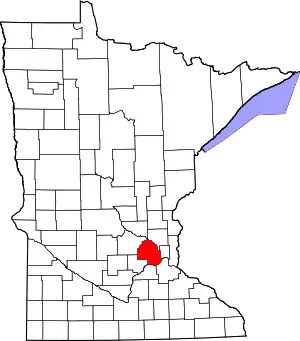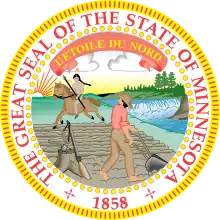New Hope, Minnesota
New Hope is a city in Hennepin County, Minnesota, United States and a suburb of Minneapolis. The population was 20,339 at the 2010 census and 20,907 at the 2019 estimate.[6]
New Hope | |
|---|---|
 Location of the city of New Hope within Hennepin County, Minnesota | |
| Coordinates: 45°2′N 93°23′W | |
| Country | United States |
| State | Minnesota |
| County | Hennepin |
| Incorporated | 1936 |
| Government | |
| • Mayor | Kathi Hemken |
| Area | |
| • Total | 5.11 sq mi (13.25 km2) |
| • Land | 5.06 sq mi (13.10 km2) |
| • Water | 0.06 sq mi (0.15 km2) 1.18% |
| Elevation | 932 ft (284 m) |
| Population | |
| • Total | 20,339 |
| • Estimate (2019)[3] | 20,907 |
| • Density | 4,134.27/sq mi (1,596.25/km2) |
| Time zone | UTC-6 (Central) |
| • Summer (DST) | UTC-5 (Central) |
| ZIP codes | 55427, 55428 |
| Area code(s) | 763 |
| FIPS code | 27-45628[4] |
| GNIS feature ID | 0648510[5] |
| Website | City of New Hope |
History
New Hope was originally a farming community in Crystal Lake Township called Hope. In 1936, the city of Crystal, was incorporated, taking up all of former Crystal Lake Township. The farmers in the western part of the city broke off and formed New Hope Township. In 1953, with suburbia moving in and farmers moving out, New Hope incorporated as a city.
Geography
According to the United States Census Bureau, the city has an area of 5.10 square miles (13.21 km2), of which 5.04 square miles (13.05 km2) is land and 0.06 square miles (0.16 km2) is water.[7] It is located 12 miles northwest of downtown Minneapolis.
Demographics
| Historical population | |||
|---|---|---|---|
| Census | Pop. | %± | |
| 1940 | 394 | — | |
| 1950 | 691 | 75.4% | |
| 1960 | 3,552 | 414.0% | |
| 1970 | 23,180 | 552.6% | |
| 1980 | 23,087 | −0.4% | |
| 1990 | 21,853 | −5.3% | |
| 2000 | 20,873 | −4.5% | |
| 2010 | 20,339 | −2.6% | |
| 2019 (est.) | 20,907 | [3] | 2.8% |
| U.S. Decennial Census[8] 2018 Estimate[9] | |||
2010 census
As of the census[2] of 2010, there were 20,339 people, 8,427 households, and 5,032 families living in the city. The population density was 4,035.5 inhabitants per square mile (1,558.1/km2). There were 9,051 housing units at an average density of 1,795.8 per square mile (693.4/km2). The racial makeup of the city was 74.5% White, 14.7% African American, 0.4% Native American, 3.8% Asian, 2.9% from other races, and 3.6% from two or more races. Hispanic or Latino of any race were 6.5% of the population.
There were 8,427 households, of which 28.4% had children under the age of 18 living with them, 43.1% were married couples living together, 12.6% had a female householder with no husband present, 4.0% had a male householder with no wife present, and 40.3% were non-families. 33.3% of all households were made up of individuals, and 13.1% had someone living alone who was 65 years of age or older. The average household size was 2.31 and the average family size was 2.97.
The median age in the city was 39.4 years. 22% of residents were under the age of 18; 7.3% were between the ages of 18 and 24; 27.8% were from 25 to 44; 24.4% were from 45 to 64; and 18.6% were 65 years of age or older. The gender makeup of the city was 46.9% male and 53.1% female.
2000 census
As of the census[4] of 2000, there were 20,873 people, 8,665 households, and 5,268 families living in the city. The population density was 4,098.6 people per square mile (1,583.3/km2). There were 8,746 housing units at an average density of 1,717.4 per square mile (663.4/km2). The racial makeup of the city was 86.66% White, 5.78% African American, 0.46% Native American, 3.21% Asian, 0.04% Pacific Islander, 1.74% from other races, and 2.11% from two or more races. Hispanic or Latino of any race were 3.45% of the population.
There were 8,665 households, out of which 27.2% had children under the age of 18 living with them, 47.2% were married couples living together, 10.4% had a female householder with no husband present, and 39.2% were non-families. 32.3% of all households were made up of individuals, and 12.5% had someone living alone who was 65 years of age or older. The average household size was 2.29 and the average family size was 2.91.
In the city, the population was spread out, with 21.3% under the age of 18, 8.1% from 18 to 24, 30.2% from 25 to 44, 22.7% from 45 to 64, and 17.8% who were 65 years of age or older. The median age was 38. For every 100 females, there were 86.6 males. For every 100 females age 18 and over, there were 83.4 males.
The median income for a household in the city was $46,795, and the median income for a family was $60,424. Males had a median income of $41,192 versus $29,454 for females. The per capita income for the city was $23,562. About 4.1% of families and 6.5% of the population were below the poverty line, including 7.8% of those under age 18 and 6.3% of those age 65 or over.
Education
New Hope is in the Robbinsdale Area school district. Schools in New Hope include Robbinsdale Cooper High School, Meadow Lake Elementary, Robbinsdale Spanish Immersion, Sonnesyn Elementary, and Holy Trinity Lutheran School, a Christian Pre-K-8 grade school of the Wisconsin Evangelical Lutheran Synod (WELS).[10]
Notable people
- Curt Hennig - professional wrestler, entombed at Gethsemane Cemetery.
- Dorothy Hokr - Minnesota state legislator.
- Tim Vakoc – first United States military chaplain to be critically injured during Operation Iraqi Freedom, died in New Hope.
- Rashad Vaughn - NBA player for Milwaukee Bucks
- Mark Thompson - Minnesota state legislator
- Mariana Cress - athlete in the 2016 Rio Olympics
- Lance Pitlick - NHL player for Ottawa Senators and Florida Panthers
References
- "2019 U.S. Gazetteer Files". United States Census Bureau. Retrieved July 26, 2020.
- "U.S. Census website". United States Census Bureau. Retrieved 2012-11-13.
- "Population and Housing Unit Estimates". United States Census Bureau. May 24, 2020. Retrieved May 27, 2020.
- "U.S. Census website". United States Census Bureau. Retrieved 2008-01-31.
- "US Board on Geographic Names". United States Geological Survey. 2007-10-25. Retrieved 2008-01-31.
- "2010 Census Redistricting Data (Public Law 94-171) Summary File". American FactFinder. U.S. Census Bureau, 2010 Census. Retrieved 23 April 2011.
- "US Gazetteer files 2010". United States Census Bureau. Archived from the original on 2012-01-25. Retrieved 2012-11-13.
- United States Census Bureau. "Census of Population and Housing". Retrieved October 28, 2014.
- "Population Estimates". United States Census Bureau. Retrieved June 8, 2018.
- "Sharing Jesus Christ with All Ages and Nations".

